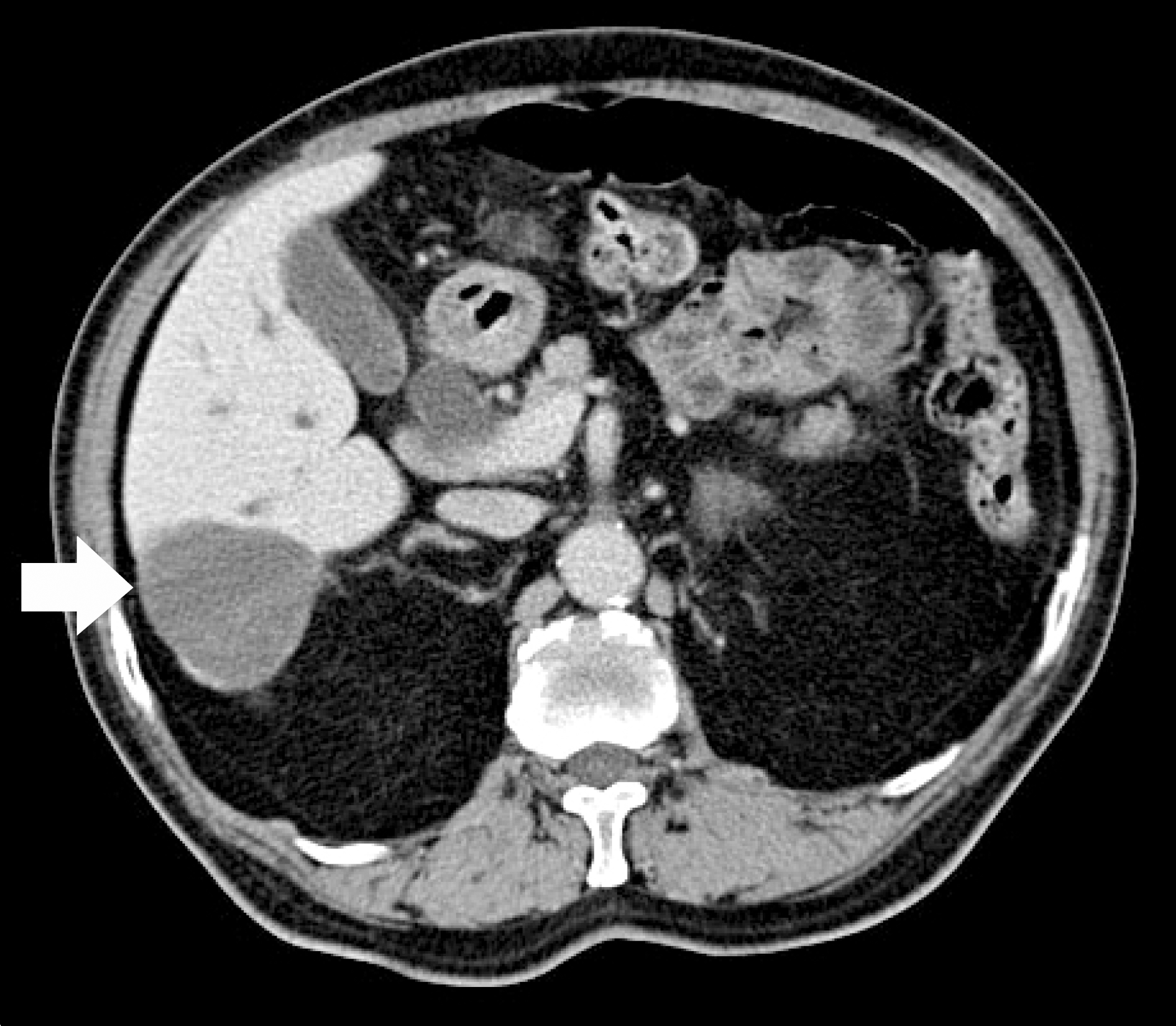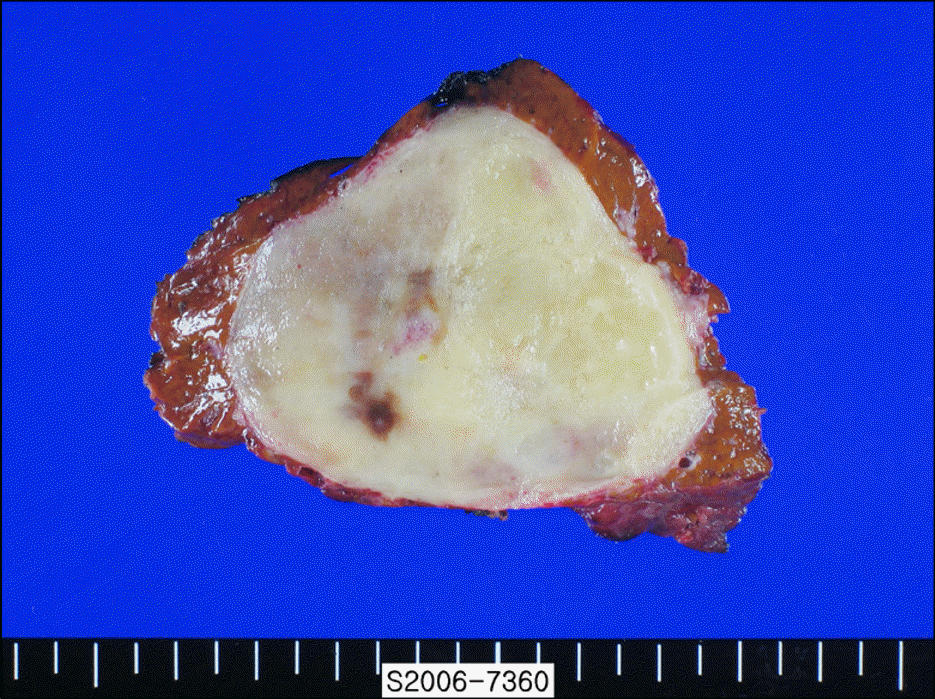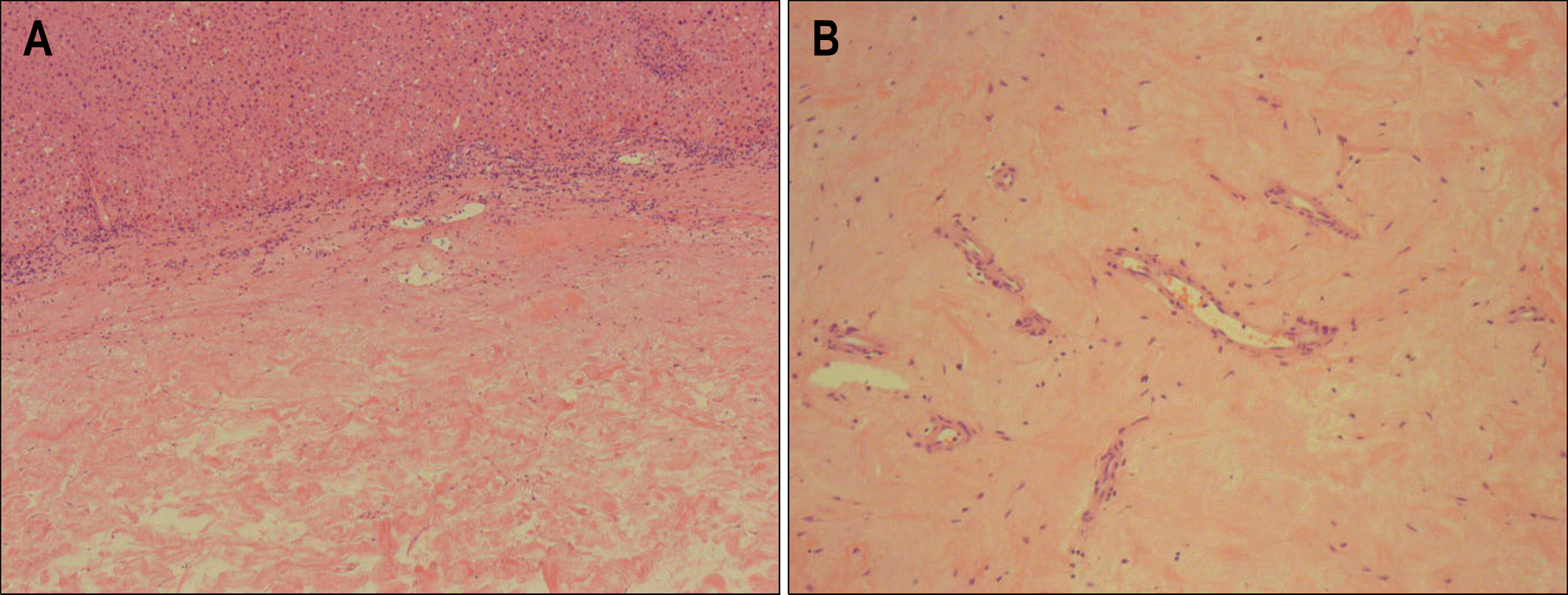Abstract
Hemangioma is one of the most frequently encountered benign hepatic neoplasm which can develop secondary degeneration. Sclerosed hemangioma is a rare disease histologically characterized by large amount of collagen and elastic fibril between sclerosed small vessels. Its differential diagnosis is very difficult. It should be included in the differential diagnosis of other hepatic lesions such as hepatocellular carcinoma, intrahepatic cholangiocarcinoma, and metastatic hepatic tumor. A 77-year old male was admitted with upper abdominal discomfort. Abdominal ultrasonography revealed GB stone, dilated common bile duct with bile duct stone, and a 4.6 cm sized hyperechoic mass at segment 5 and 6 of the liver. Abdominal dynamic computed tomography demonstrated dilated intrahepatic bile ducts and a 5×5 cm sized mass which showed minimally delayed enhancement. Abdominal magnetic resonance imaging revealed the mass with low signal intensity in T1 weighted image, high signal intensity and focal low signal in T2 weighted image which showed minimal enhancement. We removed common bile duct stone with endoscopic retrograde cholangiopancreatography then decided to undergo right lower segmentectomy of liver due to possibility of cholangiocarcinoma. Histopathological examination of hepatic mass showed large amount of fibrous tissue with occasional residual vascular channels. We describe one case of sclerosed hemangioma mimicking cholangiocarcinoma.
REFERENCES
2. Stark DD, Felder RC, Wittenberg J, et al. Magnetic resonance imaging of cavernous hemangioma of the liver: tissue-specific characterization. Am J Roentgenol. 1985; 145:213–222.

4. Semelka RC, Brown ED, Ascher SM, et al. Hepatic hemangiomas: a multi-institutional study of appearances on T2-weighted and serial gadolinium-enhanced gradient-echo MR images. Radiology. 1994; 192:401–406.
5. Choi BI, Han MC, Kim CW. Small hepatocellular carcinoma versus small cavernous hemangioma: differentiation with MR imaging at 2.0 T. Radiology. 1990; 176:103–106.

6. Goldman ZD. Benign tumors of the liver. Okuda K, Ishak KG, editors. eds.Neoplasm of the liver. Volume 1. 1st ed.Tokyo: Springer-Verlag;1987. p. 105–125.
7. Vilgrain V, Boulos L, Vullierme MP, Denys A, Terris B, Menu Y. Imaging of atypical hemangiomas of the liver with pathologic correlation. Radiographics. 2000; 20:379–397.

8. Cheng HC, Tsai SH, Chiang JH, Chang CY. Hyalinized liver hemangioma mimicking malignant tumor at MR imaging (letter). Am J Roentgenol. 1995; 165:1016–1017.
9. Mathieu D, Rahmouni A, Vasile N, et al. Sclerosed liver hemangioma mimicking malignant tumor at MR imaging: pathologic correlation. J Magn Reason Imaging. 1994; 4:506–508.

10. Haratake J, Horie A, Nagafuchi Y. Hyalinized hemangioma of the liver. Am J Gastroenterol. 1992; 87:234–236.
11. Takahashi K, Mulliken JB, Kozakewich HPW, Rogers RA, Folkman J, Ezekowitz AB. Cellular makers that distinguish the phases of hemangioma during infancy and childhood. J Clin Invest. 1994; 93:2357–2364.
12. Yamashita Y, Shimada M, Taguchi K, et al. Hepatic sclerosing hemangioma mimicking a metastatic liver tumor. Surg Today. 2000; 30:849–852.
13. Shim KS, Suh JM, Yang YS, et al. Sclerosis of hepatic cavernous hemangioma: CT findings and pathologic correlation. J Korean Med Sci. 1995; 10:294–297.

14. Takayasu K, Moriyama N, Shima Y, et al. Atypical radiographic findings in hepatic cavernous hemangioma: correlation with histologic features. AJR Am J Roentgenol. 1986; 146:1149–1153.

Fig. 1.
Abdominal computed tomography scan revealed large, elliptical, and well marginated mass in the right lower lobe of the liver with delayed partial enhancement.

Fig. 2.
Magnetic resonance imaging. (A) T1-weighted image showed a large and moderately hypointense mass. (B) T2-weighted image image showed a large, and predominant hyperintense and partial hypointense mass.

Fig. 3.
Macroscopic view of the resected tumor showed a well demarcated pale yellow to grayish soft mass with focal brownish hemorrhage.

Fig. 4.
Microscopic view of the resected tumor. (A) Low magnification showed a large amount of fibrous tissue with occasional residual vascular channels (H&E stain, ×20). (B) Higher magnification showed dense fibrous tissue between small vascular channels lined with endothelial cells (H&E stain, ×100).

Table 1.
Reported Cases of Hepatic Sclerosed Hemangioma




 PDF
PDF ePub
ePub Citation
Citation Print
Print


 XML Download
XML Download